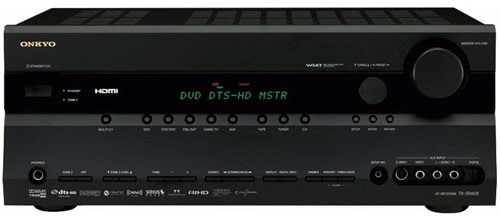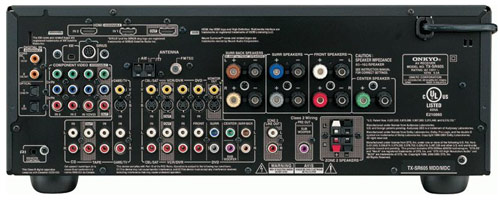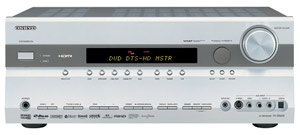Onkyo TX-SR605 HDMI-Switching Home Theater Receiver Review
By Chris Boylan
Golden Receiver
For the last couple of years, when friends have asked me for recommendations on home theater receivers, I've been a little hesitant to recommend anything. As HDMI is becoming more ubiquitous on displays and on source devices like Blu-ray Disc, HD-DVD and upconverting DVD players, it has become clear that HDMI-switching is an important feature for a receiver to include. But the evolving standards and capabilities of the fledgling HDMI format have made this a bit of a moving target.
HDMI 1.3 promised to be the culmination of HDMI technology with the inclusion of high bit-rate audio support and "DeepColor" support for compatible source and display devices. But there are usually long delays between adoption of a standard (HDMI 1.3) and implementation in actual devices. The first HDMI 1.3 sources came out toward the end of 2006 (Toshiba's
HD-XA2 HD-DVD player and Sony's
PS3 Blu-ray Disc player/gaming console). The first HDMI-1.3 compliant receivers came out earlier this year. Onkyo's
TX-SR605 was one of the first - and oddly enough the most affordable - receivers to fully exploit HDMI 1.3 (or technically "1.3a").
 Onkyo's TXSR605 Home Theater Receiver
Onkyo's TXSR605 Home Theater Receiver
Why HDMI Matters
HDMI (High Definition Multimedia Interface) is an audio/video connection interface standard that was agreed upon by both content providers (e.g., movie studios) and Consumer Electronics manufacturers. Studios like it because it can be secured against piracy or unauthorized use via the HDCP (High-bandwidth Digital Content Protection) protocol. CE manufacturers like it because it supports the latest, greatest A/V technologies and it encourages consumers to upgrade their current gear.
Consumers (and particularly reviewers like yours truly) appreciate HDMI because it greatly simplifies the connection of source devices to receivers and displays. Instead of three, five or possibly even up to eleven cables required to connect one source device to a receiver (3 for component video, and 8 for 7.1-channel analog audio), HDMI allows you to hook up a source component to a display or receiver via a single cable. And rather than compromising performance, the HDMI interface supports full bandwidth high definition video and multi-channel surround sound audio in its pure uncompressed digital form, so it's not only the simplest way, but the highest quality way to deliver your audio and video signals to your receiver or display.
There are alternatives of course: component video cables can carry high definition signals up to 1080p resolution, though this is usually limited by the CE manufacturers to 1080i. Fiberoptic or coax S/PDIF (Sony/Philips Digital Interchange Format) cables can carry stereo or multi-channel audio, though these are also limited in bandwidth. They're OK for DVD, but not really suitable for Blu-ray Disc or HD-DVD. If your DVD player, Blu-ray Disc player or HD-DVD player includes on-board surround sound codecs and multi-channel analog outputs (not all do) then you can carry the surround signals to your receiver via multiple analog (RCA) cables. But this type of connection does make your hook-up more complicated and it usually entails a sacrifice in performance due to the limited surround decoding built into many disc players.
So for simplicity and performance, HDMI is the most logical choice. But it's still not perfect. Because HDMI requires a "handshake" between source device and receiver (and display) you can sometimes run into compatibility problems that prevent you from getting a reliable connection, particularly when you complicate the issue with multiple devices in the loop (switch, receiver and display). But, for the most part, these issues and errors are getting less common as the manufacturers get better about interacting with each other's devices.
What if my source devices don't DO HDMI?
HDMI-switching receivers (including the TX-SR605) do not
require HDMI source components in order to work. They're equally happy switching standard analog video signals (composite, S-video or component video), and passing these through to your television for display. Good HDMI-switching receivers (including the TX-SR605) will convert or "transcode" the analog video signals from your VCR, game system or DVD player to HDMI output, so you'll only need one single HDMI cable between the receiver and display. This not only simplifies the cables between receiver and TV, but can also allow you to spend less on your display because you won't need one with multiple HDMI inputs: all you need is one.
OK, I get it, HDMI is Good. But what about the Onkyo receiver?
Alright, back to business. The Onkyo TX-SR605 offers two HDMI 1.3a-compatible HDMI inputs. Two is not a lot, but it's enough to hook up a high def cable or satellite receiver plus an HD-DVD, Blu-ray Disc or upconverting DVD player. If you get a universal disc player like Samsung's upcoming
BD-UP5000 which plays HD-DVDs, Blu-ray Discs and upconverts DVDs, then you won't need as many HDMI inputs on your receiver. Also, if you need more, you can always add an inexpensive
HDMI switch to extend the number of HDMI inputs.
 Onkyo's TX-SR605 features 2 HDMI and 3 component video inputs and converts analog sources to HDMI output
Onkyo's TX-SR605 features 2 HDMI and 3 component video inputs and converts analog sources to HDMI output
The Onkyo receiver also includes component video, S-video and composite video inputs and it converts these analog signals to a digital HDMI signal so you can send these signals to your display device. There is one minor caveat here that you should know about. If you connect a 1080i source device (like an HD cable box) to the Onkyo receiver via component video, the receiver will actually down-convert the video signal to 720p over HDMI so you may actually lose a bit in video quality. If you've got an older high definition source device that lacks HDMI or DVI outputs, then you're better off connecting it straight to your display via component video, or connecting a component video cable between receiver and display.
The receiver does have a built-in de-interlacer (Faroudja DCDi) which converts 480i video sources to 480p for output over HDMI or component video. It does a decent job preventing jaggies (stair-stepping distortion on diagonal lines), but it isn't perfect at detecting a 3:2 film cadence or restoring lost detail. If you're connecting a progressive scan DVD player to the receiver using component video connections, you may be better off setting your DVD player to its progressive output and letting the player do the de-interlacing. This won't be a factor if you have a newer DVD player with an HDMI output as the Onkyo passes HDMI video through to the display with no additional processing.
The component video and HDMI inputs are assignable in the Onkyo's set-up menu. Any of the 5 A/V inputs can be configured for HDMI, component video, S-Video or composite video. This means you can connect up to 5 high definition devices to the Onkyo receiver, either via HDMI (2) or component video (3). This should be plenty for most people's needs. HDMI or component inputs are specifically assigned in the set-up menu. For those inputs that have neither component video nor HDMI plugs connected, you can connect either S-Video or composite video (automatically detected). The "Tape" and "CD" inputs are audio only. Also, please note that the second zone (if used) only supports analog connections. If you want to use a CD or DVD player (for example) in a second zone, then make sure to connect it to the Onkyo using standard left/right analog connections.
How Many Watts Does It Push?
The TX-SR605 is rated to output 90 Watts/Channel with all 7 channels driven. Depending on how efficient your speakers are, this should be more than enough power for a small to medium listening room, and will even do OK with a larger room if your speakers are efficient enough. In actual listening tests, with two different brands of smaller bookshelf speakers and powered sub (NHT and Definitive Technology models), I never noticed the amplifier distorting, even at high volumes so I'd say the amplifiers in the Onkyo are clean and suitable to drive most speakers with which they're likely to be paired.
How Many Point Ones Does It Have?
The TX-SR605 supports 5.1, 6.1 and 7.1-channel configurations. The internal Audyssey/2EQ calibration software and microphone will detect which speakers are in use and will set the receiver to the correct surround mode automatically. If you are going to use a 6.1-channel configuration with a single rear-channel speaker, then connect it to the left-rear output. If you use a 5.1-channel configuration, then you can use the two extra amplifier channels either for a powered second zone or for bi-amping the front channel left and right speakers (with compatible speakers only). I used the receiver in both 5.1 and 6.1-channel configurations.

The TX-SR605's remote control is simple but functional.
Remotely Interesting
The included remote control is logically laid out, with buttons for direct input selection and backlighting on some of the important buttons. It can be programmed to operate up to six different devices, including a TV, CD player, cable or satellite box, DVD player and the receiver itself. In addition to controlling receiver functions, the remote includes buttons for menu and transport control of a compatible disc player or source device. If you don't already have a universal remote control, this one will definitely get the job done, controlling the basic functions of multiple components within your home theater system.
The Set Up
Setting up an advanced home theater processor or receiver can be a tedious process. Getting all the speaker levels, distances and cross-overs set properly, and assigning the HDMI and component inputs can easily go awry if you're not paying attention. But on the Onkyo receiver, things could not have gone more smoothly. I plugged in two HDMI source devices (one Blu-ray, one HD-DVD), plugged in another HDMI cable from the receiver into a Toshiba LCD HDTV, hit the "set-up" button on the remote and followed the on-screen/on-LCD display menu, selecting the first option "Input/Output Assign." Here I assigned HDMI 1 to the DVD input and HDMI 2 to "Aux." Pressed play on one of the players, got sound and picture and continued on to the audio calibration.
The Onkyo TX-SR605 includes the Audyssey 2EQ automatic calibration software and a microphone. When you plug the included microphone into the input on the receiver's front panel, the receiver automatically enters automatic calibration mode and generates test tones for all of the channels in the system. You can measure/calibrate the system for two different listening positions and it will calculate the ideal settings to accommodate both locations instead of creating one super-optimized setting just for one sweet spot within the room. This process is about as painless as it gets, requiring only some patience (and silence) while the receiver steps through all of the channels, makes its calculations and adjusts the speaker levels, distance, subwoofer crossover and equalization to create the best settings for your specific speakers and room. After the set-up is complete, simply unplug the microphone and enjoy the optimized, calibrated sound.
Viewing/Listening Impressions
The job of a receiver is to be as neutral as possible in translating recorded media (CDs, DVDs, MP3s, Blu-ray Discs, HD-DVDs, etc.) into pretty pictures and sounds. And to this end, the receiver was quite successful. For stereo source material, I listened to many of my favorite CDs as diverse as Wagner, Rush, Roxy Music, Enya, the Eagles, James Blunt, Fleetwood Mac, Soundgarden, Gus Black, etc., etc. Although the receiver does come with multiple matrix surround modes that enhance standard stereo sound with additional ambience (Dolby Pro Logic II, DTS Neo:6, etc.), I found the standard stereo mode to be the cleanest, best representation of stereo recordings.
With the Onkyo, stereo imaging was preserved allowing me to hear into the original soundstage of high-quality two-channel recordings. And the harmonic balance of the recordings was captured well, without excessive harshness or brittle high frequencies which you can sometimes hear with cheaper solid state amplifiers. Does it produce the kind of transparent three-dimensionality on 2-channel recordings that you'll get with the finest 2-channel preamps and power amps? Perhaps not. But it'll get you most of the way there for a whole lot less money.

The TX-SR605 is also available in silver.
For movie watching in surround, I was sure to put on a few HD-DVDs and Blu-ray Discs which featured the new lossless surround sound codecs, Dolby TrueHD and DTS-HD Master Audio. Using a Panasonic DMP-BD30, and Toshiba HD-XA2 and HD-A35 HD-DVD players, I was able to pass the lossless multi-channel surround soundtracks to the Onkyo hearing these in all their glory. Dolby TrueHD titles included "The Matrix," "The Fifth Element" and "Poseidon" on HD-DVD, "Dave Matthews and Tim Reynolds: Live at Radio City" and "Spiderman 3" on Blu-ray Disc. For DTS-HD, I used "Behind Enemy Lines" on Blu-ray Disc, and DTS Demo discs (HD-DVD and Blu-ray Disc).
The sound quality on these next generation formats is a step above what you've heard on CD and DVD. Although DVD does not suffer from problems with dynamic range, there are some subtle (and some not so subtle) artifacts of the encoding process of both DTS and Dolby Digital which can be heard on some material - steely highs, slightly confused inarticulate dialog tracks, so called "pumping" or "breathing" of the noise floor and a general lack of pinpoint imaging and dimensionality. With Dolby TrueHD and DTS-HD Master Audio, these artifacts are gone. It's the closest thing to the studio master that you've ever hear and this is because, in many cases, it is a bit-perfect copy of the studio master.
On the "Dave Matthews/Tim Reynolds" live recording, it was like actually being in the audience with the show unfolding around me. Though the dynamics of this recording are not difficult (amplified acoustic guitars and solo male vocals), subtle nuances in the strumming and individual notes stood out clearly against a velvety smooth and silent backdrop. And when Dave went off on one of his tangents, his vocal diatribes were reproduced clearly and naturally. Although I do mourn the passing of the SACD and DVD-Audio formats, these new lossless surround formats from DTS and Dolby offer sound quality that bests even those. Now let's hope the studios start to release some music titles and we'll be in business.
With standard DVDs, soundtracks were also decoded properly over HDMI, whether they were 2-channel PCM, 2-channel Dolby Digital, 5.1-channel Dolby Digital or DTS, or 6.1-channel DTS-ES or Dolby Digital-EX. Speaking of DTS-ES, one of the movies that saw time in the system during my evaluation was "Lord of the Rings: Return of the King" (standard DVD) which features a 6.1-channel DTS-ES mix. The Onkyo had no trouble identifying the DTS-ES format and properly routed the 6 channels (and the LFE track) to their respective speakers for an immersive surround experience.
Final Thoughts
In the land of home theater receivers, you generally have to make compromises and choose what matters most to you: a.)Inexpensive, B.)Feature-Packed, C.)High Quality - pick any two. Inexpensive high quality receivers generally are lacking in some features. And high quality feature-packed receivers usually lean toward the higher end of the cost spectrum. Not so with the Onkyo TX-SR605. It offers the latest state-of-the-art audio decoding, high-quality reliable auto-calibration, HDMI switching and HDMI upconversion of legacy analog video sources, and all at an affordable price. It even includes support for both satellite radio flavors and an independent powered or unpowered second zone.
About the only thing it lacks is a really high-end video processor (for upconversion of analog sources) and possibly one or two more HDMI inputs. The first issue is moot if your source or display has a high quality video processor on board already. The second can be addressed with an inexpensive HDMI switch.
For the price, it's hard to find a significant flaw or omission on this receiver. If you're looking for an affordable home theater receiver which is ready for today's highest quality audio and video sources and display devices, and ready for the future, the Onkyo TX-SR605 should be at the top of your list.
Note: In April, 2008, Onkyo is introducing the TX-SR606 as a replacement to the TX-SR605. The 606 includes 4 HDMI inputs, and does 1080i analog upconversion to HDMI addressing two of the few weaknesses of the TX-SR605. The TX-SR605 should be available at a significant discount while current stock lasts and the 606 should be a killer replacement.
Where to Buy:
Where to Buy (upgraded TX-SR606 model):
Features/Specifications of the TX-SR605:
- MSRP: $499.99
- Power Rating: 90 Watts/Channel into 7 channels
- XM- and Sirius-ready
- Audyssey 2EQ auto-calibration with included microphone
- iPod-friendly through the use of the Onkyo's DS-A2 or DS-A2X docking station (optional)
- DTS-HD High Resolution Audio, DTS-HD Master Audio, DTS-ES, DTS Neo:6, DTS 96/24, DTS
- Dolby TrueHD, Dolby Digital Plus, Dolby Digital EX, Dolby Digital, Dolby ProLogic IIx
- On-board Faroudja/DCDi Video Processor
- High Definition video support via three component video (up to 1080i) and two HDMI (up to 1080p) inputs
- Supports HDMI version 1.3a
- Composite to S-Video Conversion
- Composite and S-Video to Component Video Upconversion
- Composite, S-Video, Component Video Transcoding to HDMI digital video output
- Multichannel Analog Input (7.1-channel)
- Digital Soundfield Processing Modes
- Late Night Mode
- Detailed On-Screen Display
- Flexible Crossover Adjustments
- Dimensions (W x H x D): 17 1/8" x 6 7/8" x 14 13/16" (435 x 174 x 377 mm)
- Weight: 25.1 lbs. (11.4 kg)
- Warranty: 2 Years Parts and Labor
Manufacturer's Contact Information:
Onkyo USA Corporation
18 Park Way
Upper Saddle River, New Jersey 07458
Tel: 201-785-2600
Fax: 201-785-2650
Web site:
www.onkyousa.com



